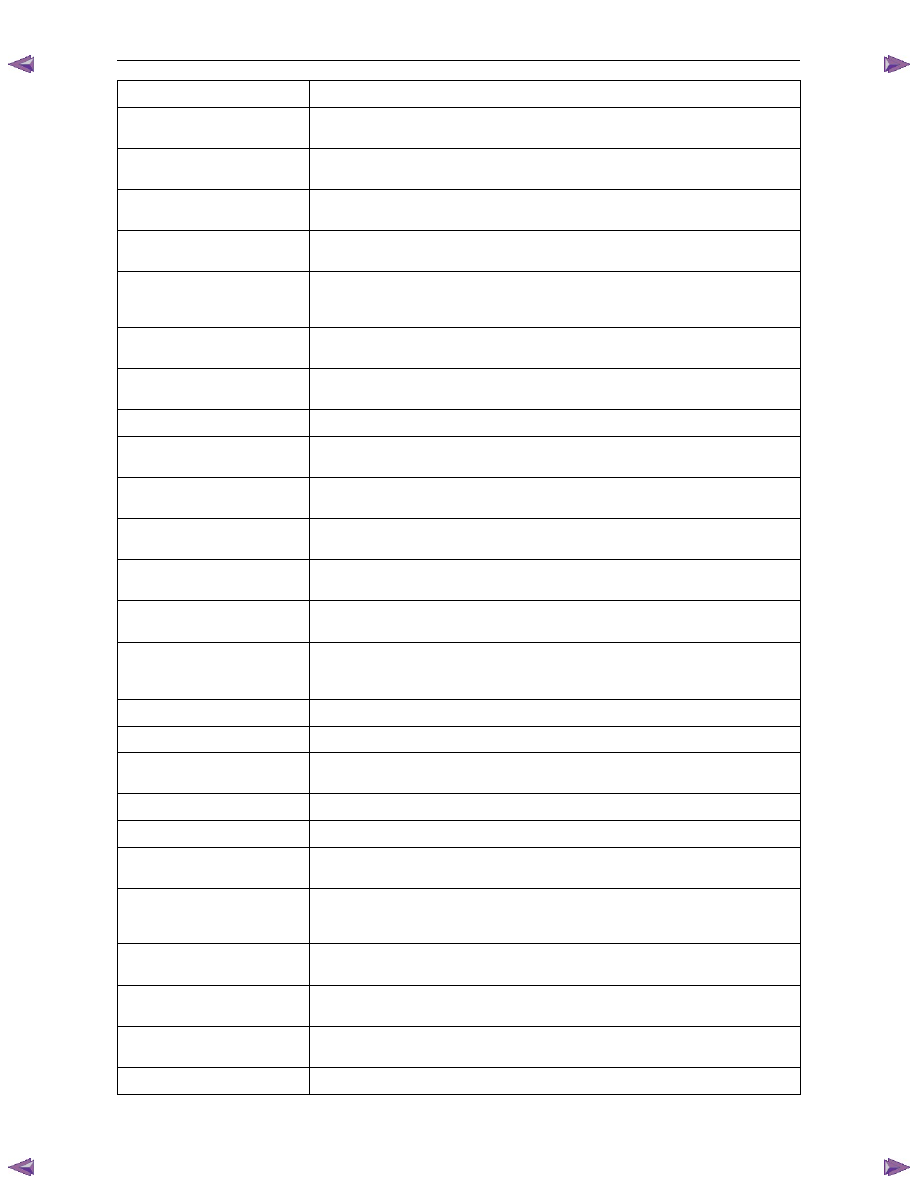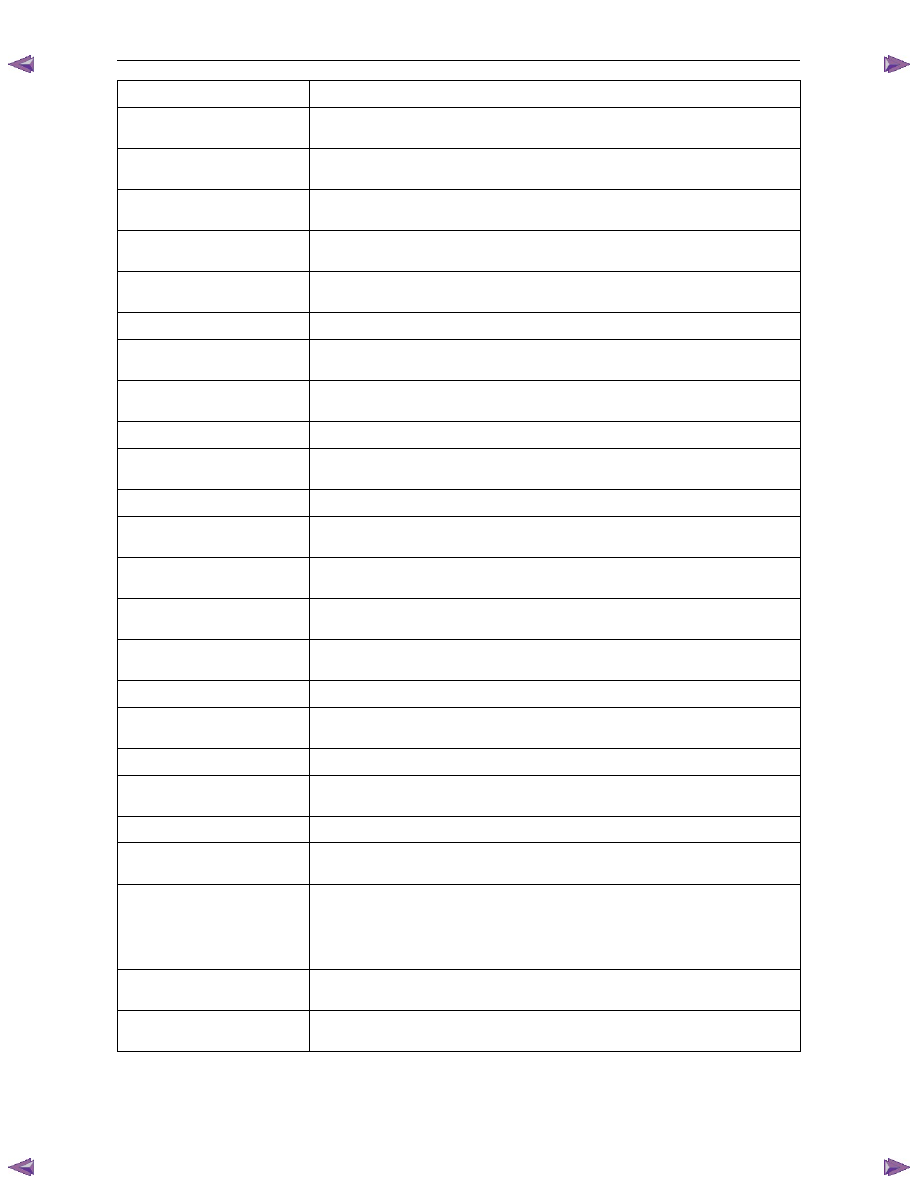Isuzu KB P190. Manual — part 943

Automatic Transmission – 4L60E – General Information
Page 7C1–12
General Definition
Check Ball
A spherical, hydraulically controlled component (usually of steel) that either seals or
opens fluid circuits. It is also referred to as a check valve.
Clutch Pack
An assembly of components generally consisting of clutch plates, an apply plate and a
backing plate.
Clutch Plate
A hydraulically activated component that has two basic designs: (1) all steel, or (2) a
steel core with friction material bonded to one or two sides of the plate.
Control Valve Body
A machined metal casting that contains valve trains and other hydraulically controlled
components that shift the transmission.
Coupling Speed
The speed at which a vehicle is travelling and no longer requires torque multiplication
through the torque converter. At this point, the stator 'free wheels' to allow fluid leaving
the turbine to flow directly to the pump. (Also see Torque Converter).
De-energise(d)
To interrupt the electrical current that flows to an electronically controlled device,
making it electrically inoperable.
Direct Drive
A condition in a gears set where the input speed and input torque equals the output
speed and output torque. The gear ratio through the gear set is 1:1.
Downshift
A change in a gear ratio where both input speed and torque increases.
Duty Cycle
In reference to an electronically controlled solenoid, it is the amount of time (expressed
as a percentage) that current flows through the solenoid coil.
Energise(d)
To supply a current to an electronically controlled device, enabling it to perform its
designed function.
Engine Compression Braking
A condition where compression from the engine is used with the transmission to
decrease vehicle speed.
Exhaust
The release of fluid pressure from a hydraulic circuit. (The words 'exhausts' and
'exhausting' are also used and have the same intended meaning.)
Fail-safe Mode
A condition whereby a component (i.e. engine or transmission) will partially function
even if its electrical circuit is disabled.
Fluid
In this Section of the Service Manual, 'fluid' refers primarily to automatic transmission
fluid (or ATF) and, for the Hydra-matic 4L60E transmission, the only recommended
fluid is Dexron
III.
Fluid Pressure
A pressure that is consistent throughout a given fluid circuit.
Force
A measurable effort that is exerted on an object (component).
Freewheeling
A condition where power is lost through a driving or holding device (i.e. roller or sprag
clutches).
Friction Material
A heat and wear resistant fibrous material, bonded to clutch plates and bands.
Gear
A round, toothed device that is used for transmitting torque through other components.
Gear Range
A specific speed to torque ratio at which the transmission is operating (i.e. 1st gear,
2nd gear etc.).
Gear Ratio
Revolutions of an input gear as compared to the revolutions of an output gear. It can
also be expressed as the number of teeth on a gear as compared to the number of
teeth on a gear that it is in mesh with.
Hydraulic Circuit
A fluid passage which often includes the mechanical components in that circuit
designed to perform a specific function.
Input
A starting point for torque, revolutions or energy into another component of the
transmission.
Internal Gear
The outermost member of a gear set that has gear teeth in constant mesh with the
planetary pinion gears of the gear set.
Land (Valve Land)
The larger diameters of a spool valve that contact the valve bore or bushing.

Automatic Transmission – 4L60E – General Information
Page 7C1–13
General Definition
Line Pressure
The main fluid pressure in a hydraulic system created by the pump and pressure
regulator valve.
Manual Valve
A spool valve that distributes fluid to various hydraulic circuits and is mechanically
linked to the gear selector lever.
Orifice
A restricting device (usually a hole in the spacer plate) for controlling pressure build up
into another circuit.
Overdrive
An operating condition in the gear set allowing output speed to be higher than input
speed and output torque to be lower than input torque.
Overrunning
The function of a one-way mechanical clutch that allows the clutch to freewheel during
certain operating conditions of the transmission.
Pedal Position
The percentage angle of the accelerator pedal as displayed by Tech 2.
Pinion Gears
Pinion gears (housed in a carrier) that are in constant mesh with a circumferential
internal gear and centralised sun gear.
Planetary Gear Set
An assembly of gears that consists of an internal gear, planet pinion gears with a
carrier, and a sun gear.
Pressure
A measurable force that is exerted on an area and expressed as kilopascals (kPa).
Pulse Width Modulated (PWM)
An electronic signal that continuously cycles the On and Off time of a device (such as
a solenoid) while varying the amount of On time.
Race (Inner or Outer)
A highly polished steel surface that contacts bearings or sprag or roller elements.
Reduction (Gear Reduction)
An operating condition in the gear set allowing output speed to be lower than input
speed and output torque to be higher than input torque.
Residual Fluid Pressure
Excess pressure contained within an area after the supply pressure has been
terminated.
Roller Clutch
A mechanical clutch (holding device) consisting of roller bearings assembled between
inner and outer races.
Servo
A spring loaded device consisting of a piston in a bore that is operated (stroked) by
hydraulic pressure to apply or release a band.
Spool Valve
A round hydraulic control valve often containing a variety of land and valley diameters.
Sprag Clutch
A mechanical clutch (holding device consisting of "figure eight" like elements
assembled between inner and outer races.
Staking
The effect of deforming, peening over or riveting a shaft to provide a solid mounting.
Throttle Position
The travel of the throttle plate that is expressed in percentages and measured by
Tech 2.
Torque
A measurable twisting force expressed in terms of Newton metres (Nm).
Torque Converter
A component of an automatic transmission, (attached to the engine flex plate) that
transfers torque from the engine to the transmission through a fluid coupling.
Torx
Plus Bit
A special tool used for the removal of the bell housing. Precision tip fit means that cam
out of the bolt head is virtually eliminated.
N O T E
Torx Plus Bits are different from normal Torx Bits
Transmission Control Module
(TCM)
An electronic device that manages the vehicle's engine and automatic transmission
functions.
Variable Capacity Pump
The device that provides fluid for operating the hydraulic circuits in the transmission.
The amount of fluid supplied varies depending on vehicle operating conditions.

Automatic Transmission – 4L60E – General Information
Page 7C1–14
4.4 Abbreviations
Abbreviation Definition
2WD
Two Wheel Drive.
AC Alternating
Current
A/C Air
Conditioning
AFL
Actuator Feed Limit
4WD Four
Wheel
Drive
DC Direct
Current
D.C Duty
Cycle
DLC Diagnostic
Link
Connector
DTC
Diagnostic Trouble Code
ECM Engine
Control
Module
ECT Sensor
Engine Coolant Temperature Sensor.
ETC Electronic
Throttle
Control
N.C Normally
Closed
N.O. Normally
Open
PCS
Pressure Control Solenoid (or Force Motor)
PIM
Powertrain Interface Module
PWM
Pulse Width Modulated
RWD
Rear Wheel Drive.
TCC
Torque Converter Clutch.
TCM
Transmission Control Module
TFP Switch
Transmission Fluid Pressure Manual Valve Position Switch
TFT
Transmission Fluid Temperature Sensor.
TP Sensor
Throttle Position Sensor.
VS Sensor
Vehicle Speed Sensor.
Automatic Transmission – 4L60E – General Information
Page 7C1–15
5 Service
Notes
In the interests of safety to personnel, equipment and to the vehicle and its components, read and adhere to the following
notes whenever servicing operations are to be carried out on the Hydra-matic 4L60E automatic transmission. In addition,
some of this information also refers to sound workshop practices and, to achieve the design life of affected components.
Fasteners
•
Always reinstall fasteners in the same locations as they were removed.
•
If a fastener requires replacement, always use a part of the correct part number or of equal size and strength or
stronger.
General Workshop Practice
•
Keep work area and tools clean.
•
To avoid unnecessary contamination, always clean the exterior of the transmission before removing any parts.
•
Do not use wiping cloths or rags because of the risk of lint being trapped in the transmission.
•
Do not use solvents on:
•
neoprene seals,
•
composition faced clutch plates, or
•
thrust washers.
•
Always wear eye protection when using compressed air.
•
Blow out all passages with compressed air. Only probe small passages with soft, thin wire.
•
Handle parts with care to avoid nicks and scratches.
•
Do not remove Teflon oil seal rings unless damaged or performing a complete overhaul.
•
Expand internal snap rings and compress external snap rings to maximise retention and security.
•
Lubricate all internal parts with transmission fluid (only use Dexron® III), as they are being installed.
•
When installing cap screws into aluminium castings:
•
always use a torque wrench and
•
stripped or damaged threads in aluminium castings may be reconditioned by using commercially available
thread inserts.
•
Once removed, replace all gaskets, seals and O-rings with new parts.
•
Always use seal protectors where indicated and do not use gasket cement or sealant on any joined face unless
specified to do so.

Нет комментариевНе стесняйтесь поделиться с нами вашим ценным мнением.
Текст